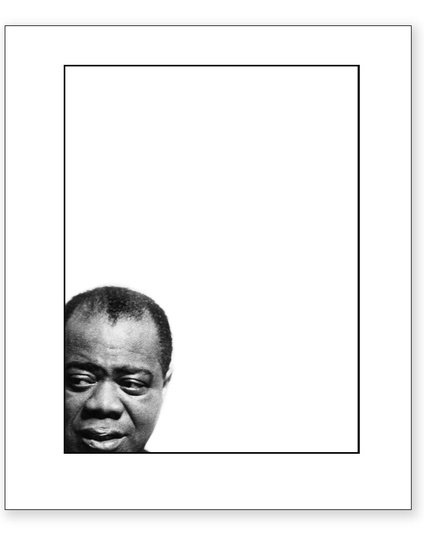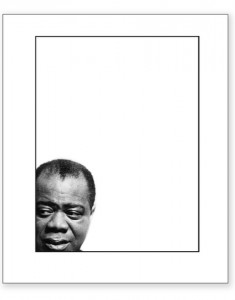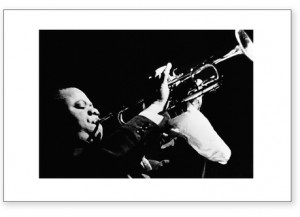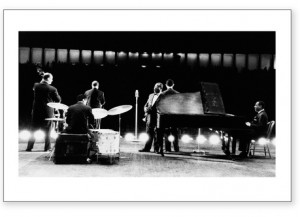Metronome Magazine: Louis Armstrong
(August 4, 1901 – July 6, 1971) nicknamed “Satchmo” or “Pops”
Coming to prominence in the 1920s as an “inventive” trumpet and cornet player, Armstrong was a foundational influence in Jazz, shifting the focus of the music from collective improvisation to solo performance. With his instantly recognizable gravelly voice, Armstrong was also an influential singer, demonstrating great dexterity as an improviser, bending the lyrics and melody of a song for
 expressive purposes. He was also skilled at scat singing (vocalizing using sounds and syllables instead of actual lyrics).
expressive purposes. He was also skilled at scat singing (vocalizing using sounds and syllables instead of actual lyrics).
Renowned for his charismatic stage presence and voice almost as much as for his trumpet-playing, Armstrong’s influence extends well beyond Jazz music, and by the end of his career in the 1960s, he was widely regarded as a profound influence on popular music in general. Armstrong was one of the first truly popular African-American entertainers to “cross-over”, whose skin color was secondary to his music in an America that was severely racially divided. He rarely publicly politicized his race, often to the dismay of fellow African-Americans, but took a well-publicized stand for desegregation during the Little Rock Crisis. His artistry and personality allowed him socially acceptable access to the upper echelons of American society that were highly restricted for a black man.
As with his trumpet playing, Armstrong’s vocal innovations served as a foundation stone for the art of Jazz vocal interpretation.
The uniquely gritty coloration of his voice became a musical archetype that was much imitated and endlessly impersonated. His scat singing style was enriched by his matchless experience as a trumpet soloist. His resonant, velvety lower-register tone and bubbling cadences on sides such as “Lazy River” exerted a huge influence on younger white singers such as Bing Crosby.
The influence of Armstrong on the development of jazz is virtually immeasurable. Yet, his irrepressible personality both as a performer, and as a public figure later in his career, was so strong that to some it sometimes overshadowed his contributions as a musician and singer.
As a virtuoso trumpet player, Armstrong had a unique tone and an extraordinary talent for melodic improvisation. Through his playing, the trumpet emerged as a solo instrument in jazz and is used widely today. He was a masterful accompanist and ensemble player in addition to his extraordinary skills as a soloist. With his innovations, he raised the bar musically for all who came after him.
Billie Holiday and Frank Sinatra are just two singers who were greatly indebted to him. Holiday said that she always wanted Bessie Smith’s ‘big’ sound and Armstrong’s feeling in her singing. Even special musicians like Duke Ellington have praised Armstrong through strong testimonials. Duke Ellington said, “If anybody was a master, it was Louis Armstrong.” In 1950, Bing Crosby, the most successful vocalist of the first half of the 20th century, said, “He is the beginning and the end of music in America.”
Armstrong had many hit records including “Stardust”, “What a Wonderful World”, “When The Saints Go Marching In”, “Dream a Little Dream of Me”, “Ain’t Misbehavin'”, “You Rascal You”, and “Stompin’ at the Savoy”. “We Have All the Time in the World” was featured on the soundtrack of the James Bond film On Her Majesty’s Secret Service, and enjoyed renewed popularity in the UK in 1994 when it featured on a Guinness advertising. It reached number 3 in the charts on being re-released.
In 1964, Armstrong knocked The Beatles off the top of the Billboard Hot 100 chart with “Hello, Dolly!”, which gave the 63-year-old performer a U.S. record as the oldest artist to have a number one song.
In 1968, Armstrong scored one last popular hit in the United Kingdom with “What a Wonderful World”, which topped the British charts for a month; however, the single did not chart at all in America. The song gained greater currency in the popular consciousness when it was used in the 1987 movie Good Morning, Vietnam, its subsequent re-release topping many charts around the world. Armstrong even appeared on the October 28, 1970, Johnny Cash Show, where he sang Nat King Cole’s hit “Rambling Rose” and joined Cash to re-create his performance backing Jimmie Rodgers on “Blue Yodel No. 9”.
Armstrong was posthumously awarded the Grammy Lifetime Achievement Award in 1972 by the Academy of Recording Arts and Sciences. This Special Merit Award is presented by vote of the Recording Academy’s National Trustees to performers who, during their lifetimes, have made creative contributions of outstanding artistic significance to the field of recordin
In the summer of 2001, in commemoration of the centennial of Armstrong’s birth, New Orleans’s main airport was renamed Louis Armstrong New Orleans International Airport.
In 2002, the Louis Armstrong’s Hot Five and Hot Seven recordings (1925–1928) were preserved in the United States National Recording Registry, a registry of recordings selected yearly by the National Recording Preservation Board for preservation in the National Recording Registry of the Library of Congress.
The US Open tennis tournament’s former main stadium was named Louis Armstrong Stadium in honor of Armstrong who had lived a few blocks from the site.
Today, there are many bands worldwide dedicated to preserving and honoring the music and style of Satchmo, including the Louis Armstrong Society located in New Orleans, Louisiana.
Louis Armstrong “Paris Blues”
Photographer: Herb Snitzer
Year Photo Taken: c. 1961
Photo appeared in Metronome Magazine in the April, 1961 issue on page 16, article entitled, “Paris Blues” and the October, 1961, issue on page 13, article entitled, “Louis Armstrong: His Records; His Influence.”
Louis Armstrong “Satchmo in New York City”
Year Photo Taken: c. 1946
Louis Armstrong “Performing Live”
Year Photo Taken: 1940
Louis Armstrong “On The Road With His Orchestra”
Photographer: Herb Snitzer
Year Photo Taken: July 3, 1960
Back to Artist List
Back to Metronome Main Page




